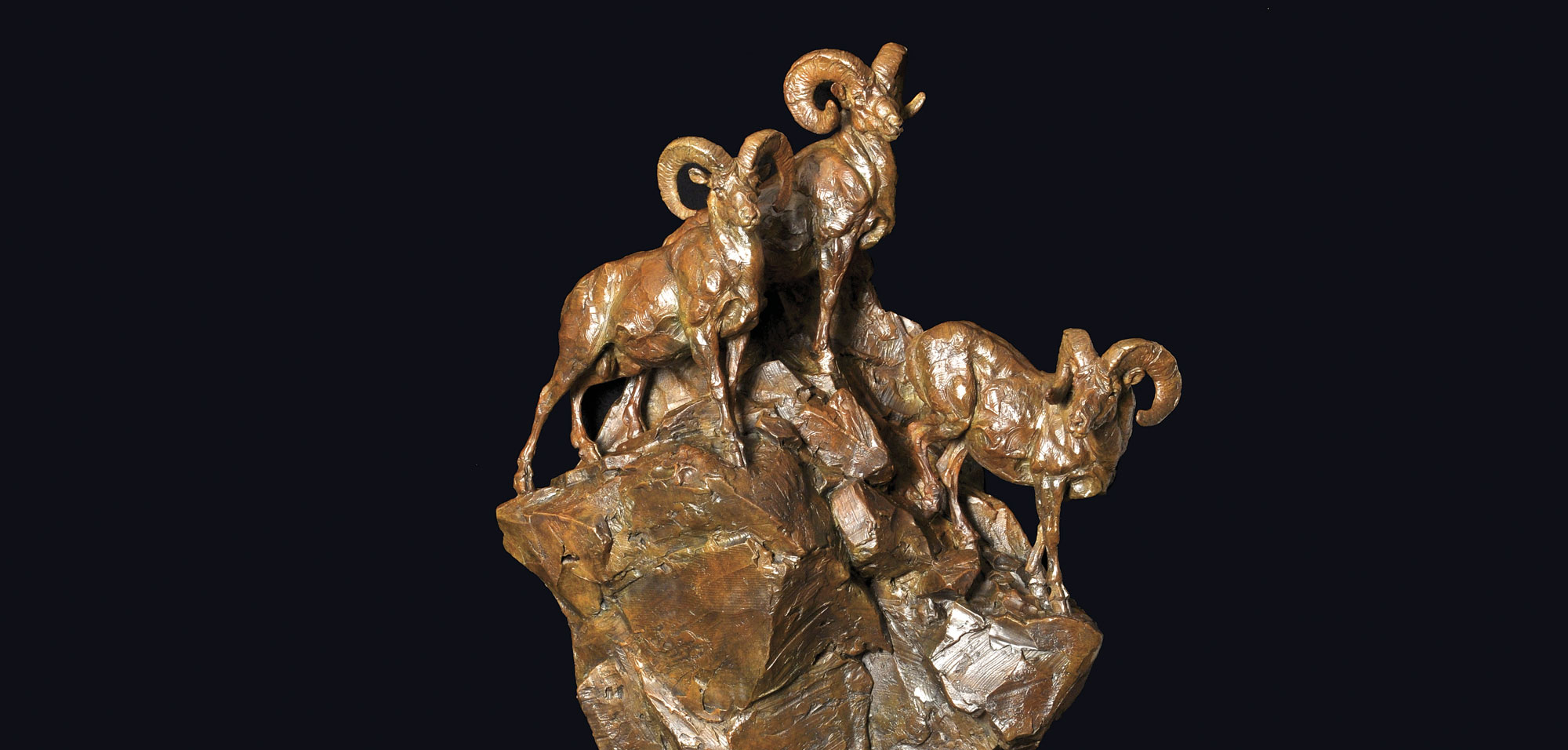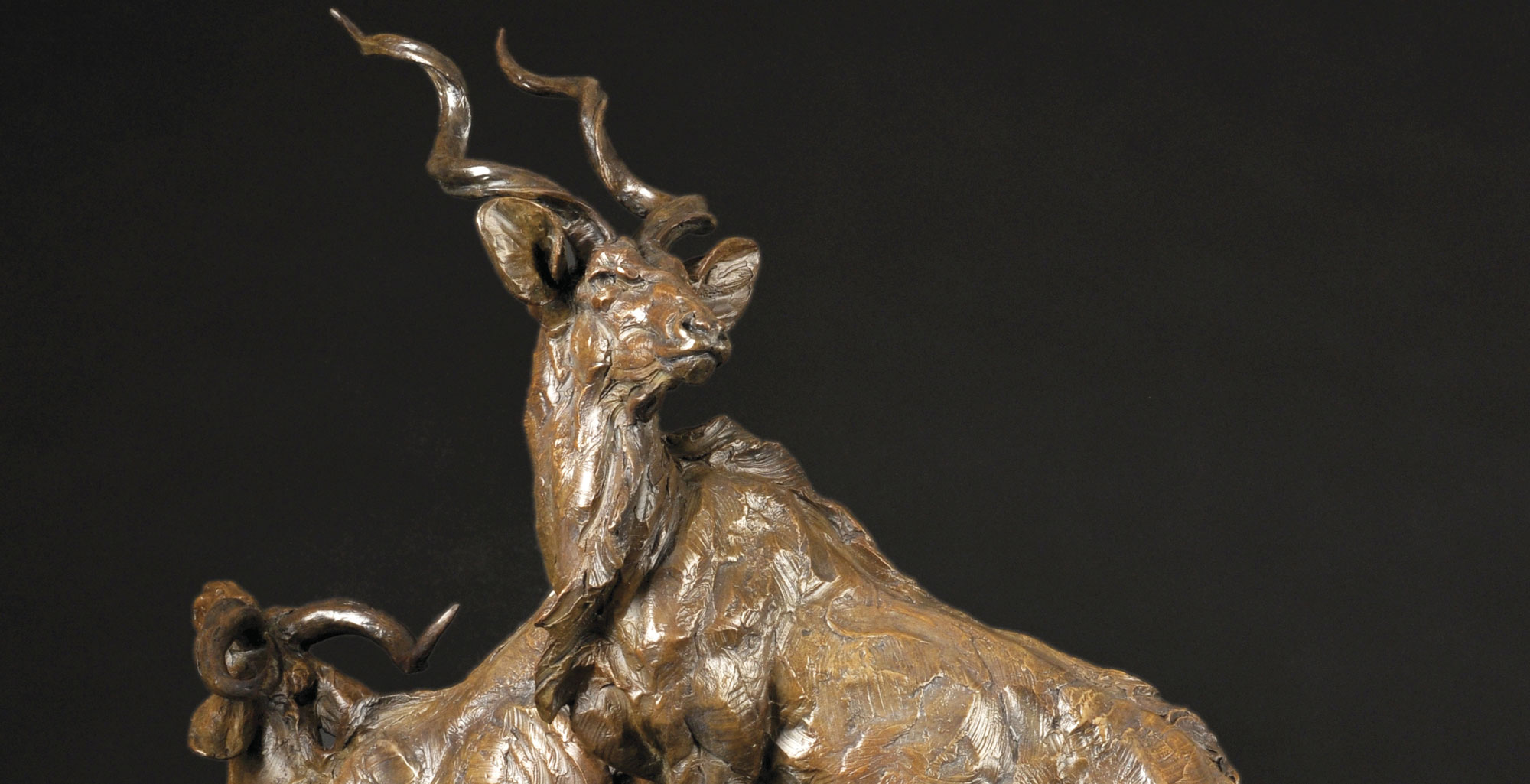
04 Aug Back From the Beyond
FOR AN ARTIST WHO WANTS A PLACE IN ART HISTORY, courting risk and leaving safety nets behind are not options. Indeed, in retrospect, they are what separate the sublime and memorable from the wear of the mundane and ultimately, the forgotten.
Today, Tim Shinabarger is leading us out on the ledge of a precipice. Three bighorn sheep rams straddle an abstracted, inverted pyramid of rock. Perched on a headwall, they literally hang before the viewer. Reminiscent of the way painter Carl Rungius approached his subjects in the high ramparts of the West, this dramatic portrayal is all about light, shadow, shapes and patterns.
The Mountaineers — his 4-foot bronze — hovers not as a bas-relief trying to mimic a flatwork, but as a three-dimensional “landscape sculpture” set in high relief. Most notably, it represents Shinabarger’s triumphant return.
“It’s good to be back,” the American wildlife artist says, “but I have to confess that being away for awhile is what enabled me to become re-energized. I haven’t felt this inspired in years.”
In mid-September, Shinabarger opens a one-man show at Legacy Gallery in Jackson Hole, Wyoming. The much-anticipated event features at least 10 new major works, each rising out of the artist’s 18-month, self-imposed studio exile.
Along with his ram piece, there’s a running warthog tabletop, kudu bulls towering over an anthill, a pair of lions and busts of Cape buffalo and sable (based upon his forays in Africa). There’s also a figurative predicament scene portraying a man on horseback descending a switchback, and depictions of large quadrupeds encountered in the wilds of Alaska and the North American West.
“In the gallery business you get the opportunity to meet and see the work of a lot of young artists,” reflects Legacy owner Brad Richardson. “In 1991, we were fortunate to meet Tim Shinabarger. He is one of the few young artists that lived up to what we thought he could become, and more.”
Shinabarger, now just shy of 50, isn’t trying to defy anyone’s previous expectations, other than saying he agrees with critics who complain that so much Western art in recent years has become cautious and predictable. His colleague, the American sporting and wildlife sculptor Walter Matia, shares Shinabarger’s sentiment.
According to Matia, Shinabarger is trying to stake out different ground — to bring authentic modern interpretations of age-old classicism and to escape endless cycles of self-derivativeness.
Shinabarger’s decision in late 2011 to embark upon a sabbatical lasting a year and a half was gutsy, considering it took place in the prime of his career during a recessionary economy when many collectors had turned fickle and more discriminating. His pieces were actually selling well. He was in a position where he could coast. But he felt he had no other choice. Gnawing at him was frustration over being caught in the grind of production. If one doesn’t make the time to heed an inner calling — to stay in touch with the very reason one became an artist — then the only sure outcome, he says, is getting lost in regret.
“Every one of us goes through an evolution of simply trying to get it right and then, if we have it in us, moving onto what is actually worth talking about in the sculptures we do,” Matia says. “Tim, because of his observational skills, started out as a great modeler.”
Two decades ago, as Richardson’s words attest, this denizen of the small Yellowstone River city of Billings, Montana, burst onto the sculpture scene with great promise. Shinabarger had grown up hunting and fishing in the nearby Absaroka-Beartooth mountains, demonstrating an early talent for drawing and painting. Then he became interested in sculpture, giving up the brush, inspired by a broad spectrum of influences that range today from the French animaliers and Russian Paolo Troubetzkoy to Ken Bunn, Jonathan Kenworthy and Dylan Lewis. During those early years, I had numerous conversations with a confident, hard-charging Shinabarger. At the time, he was spending the warmer months working as a backcountry ranger for the Forest Service and as a big-game guide in the fall, sketching subjects from life and from handling animals harvested in the field.
The experience trained his hands and eyes to the nuances of animal anatomy and musculature. At night around camp, the self-taught Shinabarger would complete little models of elk, moose and deer in wax and clay. He became fluent in communicating the exact features of his subjects, and his skill as a modeler won admiration from many elders, including the late master wildlife painter Bob Kuhn.
His work also received critical attention. At the National Cowboy & Western Heritage Center’s Prix de West Invitational, he has won the James Earle Fraser Sculpture Award four times (the most of any sculptor) and the Red Smith Award at the National Museum of Wildlife Art. Further, he was elected a fellow of the National Sculpture Society, served on the NSS board and had one of his pieces purchased for the permanent collection of the Autry National Center in Los Angeles. Still, he remained restless.
Richardson says that he and his wife, Jinger, began collecting Shinabarger years ago and today have a variety of his works. Richard’s favorite is an elk piece titled Black Timber Bugler, a monument-sized version of which resides in the permanent collection of the National Museum of Wildlife Art. “Tim’s work shows maturity beyond his years and has made him one of America’s top sculptors,” Richardson says.
Although Shinabarger is comfortable with being tagged a devotee of Realism, he does not aspire to be a literal interpreter. “He basically could tell a terrific story about a momentary event — and for many that alone is good enough. But in representational sculpture, that’s not the real hard part,” Matia says. “The hard part is deciding what it is about the event that needs further examination, and that’s when sculpture becomes artful. Having known Tim for 20-some years, what’s been wonderful to see is that maturation from being satisfied with simply telling a story to actually talking about what is truly beautiful and knowing that vision is what brings us to better understanding.”
Contemplating the challenge that Shinabarger embraces, Matia adds, “The death of most wildlife sculpture and painting is evident when you look at a piece as a viewer and all you know, all that is before you, is what you already know. There’s a lot of that out there.”
Secluded in his studio in the pastoral outskirts of Billings, free of electronic distractions and calls from galleries and clients, Shinabarger settled into a rhythm — a method based on dynamic interplay. He would sometimes have 10 different pieces going at once on various sculpting tables and pedestals, feeding off of one another and pushing him past barriers that stopped him before. The wall sculptures, in fact, represent a convergence of painting and metal mass that he previously treated as wholly separate media.
No, Shinabarger doesn’t paint his pieces, but he realizes how the visual experience of confronting a painting can be applied to making interaction with sculpture more powerful. One insight: Let sculpture be viewed at eye level. His greatest discovery, however, pertains to how he works.
“Years ago, I had had conversations with [painter] James Reynolds and [sculptor] Hollis Williford about why they worked this way [not just having a few but several pieces going at a time],” Shinabarger says. “I didn’t really understand it, but only recently it started to make sense.”
Shinabarger became more aware of different kinds of visual planes and adopting a profoundly broader approach to surface texture, aimed at heightening the impact of illusion. “The biggest thing is that I was no longer afraid to scrap a piece and start over because with more going I was less invested in fighting with it, forcing it to become something it isn’t,” he explains.
“James’ [Reynolds’] work always looked spontaneous and non-labored, as if he had painted alla prima, working up his surfaces in a single creative explosion and getting it right the first try, but that effect actually came from starting and wiping clean, over and over, building down after building up, experimenting until you reach what you’re after.”
Shinabarger admits there had been stretches over the years where he left the studio feeling tired and burned out. What happened in his studio — a phenomenon he cannot explain — has restored his vigor and set him free. “When I was younger, I had ideas but I couldn’t approach them because I didn’t know how to execute,” he says.
Gary Turner, owner of Art Castings of Montana, has, depending upon the year, between 30 and 40 sculptors who pass through his full-service foundry. His clients include Shinabarger and others such as Richard Loffler, Greg Kelsey, Floyd Tenneson DeWitt, Ott Jones, Con Williams, George Bumann, Philippe Faraut and Sam Terakedis.
“What I’ve come to admire about Tim is that he’s pushing himself, not doing things because they’re convenient or easy,” Turner says. “He’s not worried about everyone else and he understands why every step of the process matters, from clay to patina and the finer details of what makes a piece look great on display.”
From those early days of imprinting the outlines of subjects on his brain, to studying other sculptors on research trips, to makeshift tools he’s gathered to cut and ply clay, to numerous sojourns into the wilderness, and on to collaborating with master patineur Diana McClaran at Art Castings of Montana, Shinabarger says he finally feels competent to draw upon his “full creative arsenal.”
“Tim has all the hand skills, but he recognizes it’s really a head game at this point. The Holy Grail isn’t arriving at a place. It’s in the trying to get there,” Matia says. “He puts more pressure on himself than anyone has a right to. I hope to God he is rewarded for it. He has a string of big ideas that, when well executed, read much larger than they actually are.”
So let us return to the question: Where does Shinabarger fit into the continuum of art history? When posed to Adam Duncan Harris, the curator at the National Museum of Wildlife Art, he replies: “Tim Shinabarger is like an elder statesman of wildlife art without actually being very old. He has risen to the top and has remained there with work that is consistently innovative and of the highest quality,” Harris explains, sharing a story about Shinabarger’s acclaimed piece A Clash of Thunder, portraying two jousting bighorn sheep rams presented in a circular whirl.
“Tim dared to be different in a market that all too often relies on tried-and-true formulas, but it really struck a chord with people,” Harris says. “I think he had some trepidation about how it would be received, but the edition sold out almost immediately. In addition to doing great things experimenting with form, gesture and composition, Tim is not shy about experimenting with patina. His cool, bluish polar bear, for example, uses an atypical patina to great effect.”
Colleague and friend, Tim Cherry, describes the Shinabarger-Legacy connection as a bit of a throwback to the days when it was normal for artists to disappear, to go off the radar screen and re-emerge with a gallery hosting the return. “It’s going to be an exciting show,” Cherry says. “These days, taking a sabbatical and immersing yourself in solitude is pure bravery. It’s taking a chance and believing in yourself, knowing that you’ll find a way in and out again. To follow the course, you have to be true to yourself. Now we’ll see what resides in Tim’s heart.”
Legacy plans to display Shinabarger’s works in a standalone central space with walls darkened to try to replicate that sense of visual synergy that propelled their creation. Richardson and Shinabarger are also erecting special lighting to illuminate the works from all angles. What viewers won’t hear is Shinabarger’s own mental soundtrack, audible only to him.
“Clyde Aspevig [the Montana landscape painter] always told me that painting for him was like playing an instrument that becomes an extension of who you are. I never felt that when I was younger,” Shinabarger says. “Though I do now.”
Todd Wilkinson, a regular contributor to WA&A, is author of the new book, Last Stand: Ted Turner’s Quest to Save a Troubled Planet.
- “The Mountaineers (detail)” | Bronze | 48 x 23 x 10 inches | 2013
- “Wild Thing (detail)” | Bronze | 14 x 14 x 17 inches | 2013
- “The Mirage (detail)” | Bronze | 27 x 16 x 20 inches | 2013
- “The Big Itch” | Bronze | 36 x 16 x 15 inches | 2013
- Tim Shinabarger











No Comments